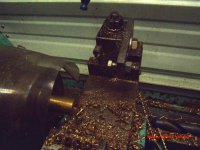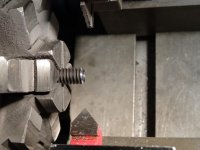I have a job coming up where i need to cut about 800 3/8' ACME threaded rods to length (material is mild steel). I picked up an affordable but good running hardinge DV59 to do this work. It has a lever cross slide and collet closer.
I am wondering what type of parting tool i should go with? I'd like to use carbide but i'm not sure how the insert would hold up when initiating the cut over threads. A parting tool .090" wide would also ensure that at least part of the insert is in the cut, so maybe it would be ok?
Would high speed steel work better for this application?
For whats is worth, the lathe has a working pump system for continuous application of cutting oil.
I am wondering what type of parting tool i should go with? I'd like to use carbide but i'm not sure how the insert would hold up when initiating the cut over threads. A parting tool .090" wide would also ensure that at least part of the insert is in the cut, so maybe it would be ok?
Would high speed steel work better for this application?
For whats is worth, the lathe has a working pump system for continuous application of cutting oil.






